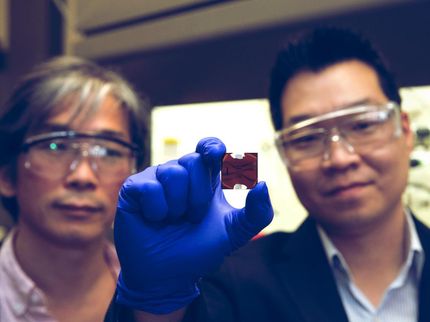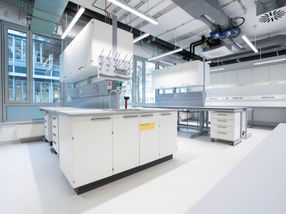Flash-freezing silicon mimics Big Bang
New ideas for manufacturing defect-free layers of semiconductor materials
Advertisement
Solar cells and computer chips need silicon layers that are as perfect as possible. Every imperfection in the crystalline structure of a silicon wafer increases the risk of reduced efficiency or defective switching processes. If you know how silicon atoms arrange themselves to form a crystal lattice on a thin surface, you gain fundamental insights into controlling crystal growth. To this end, a research team from the Helmholtz-Zentrum Dresden-Rossendorf (HZDR), the University of Duisburg-Essen and the Canadian University of Alberta analyzed the behavior of silicon that was flash-frozen. The results show that the speed of cooling has a major impact on the structure of silicon surfaces. The underlying mechanism may also have occurred during phase transitions in the early universe shortly after the Big Bang.
At low temperatures, pairs of silicon atoms known as dimers are formed on the surface of the silicon which can tilt to the right or left like a seesaw. Above a certain critical temperature – in the case of silicon 190 Kelvin (−83 °C) – the dimers rock backwards and forwards between the two states. “When they are cooled below the critical temperature, the dimers lock into one of the two states,” says Dr. Gernot Schaller, Head of Quantum Information Technology at HZDR’s Institute of Theoretical Physics. “They are effectively frozen by this phase transition.”
Moreover, the individual dimers influence each other. This influence is dependent on the arrangement of the dimers: the coupling in the transverse direction is stronger than in the longitudinal. “And it is precisely this strong so-called anisotropy that is essentially responsible for the dimers’ behavior on the surface,” says Schaller. “Depending on the cooling rate we see a transition from one-dimensional behavior to two-dimensional.” One-dimensional means that when the cooling is extremely fast, more than 100 Kelvin per microsecond, the dimers’ tilt angles arrange themselves along long chains. If the temperature drops more slowly, however, two-dimensional behavior prevails. In this case the silicon dimers form more or less large, ordered surfaces, known as domains, characterized by a uniform honeycomb structure. “And the slower the cooling, the larger the domains,” explains Schaller.
To calculate the crystal surface structure the researchers employed the so-called Ising model. This mathematical model considers the silicon dimers’ tilt angles which can only assume one of two possible states. This elegant description of a phase transition during the rapid cool-down of silicon surfaces thanks to the anisotropic Ising model is not just pure theory. The researchers also compared their analytical and numerical calculations with experimental data.
Honeycomb and zigzag chains
High-resolution scanning tunnel microscope images of flash-frozen silicon surfaces reveal structures that correspond to the simulations. Both extended two-dimensional honeycomb structures and sharp one-dimensional boundaries between zigzag-shaped chains can be seen. “And our colleagues at the University of Duisburg-Essen are planning further experiments that could confirm the impact of the cooling rate on the structure of the silicon surface – in analogy to our simulations,” says Prof. Ralf Schützhold, director of HZDR’s Institute of Theoretical Physics.
The results not only generate new ideas for the tailored manufacture of defect-free silicon surfaces, “the way the silicon dimers behave exhibits parallels with the so-called Kibble-Zurek mechanism,” says Schützhold. Named after the theoretical physicists, Tom Kibble and Wojciech H. Zurek, this theoretical model describes how topological defects, that is, imperfections in an ordered structure, are formed during fast phase transitions. Kibble looked at processes during the cooling of the very young universe following the Big Bang. Topological defects, such as point-like monopoles or linear defects – the cosmic strings – could have been created in this way. Zurek predicted analogous behavior in condensed matter using the example of cryogenic superfluid helium. And now the team around Schaller and Schützhold has shown that the Kibble-Zurek mechanism is apparently much more widespread than originally expected and can even occur on flash-frozen silicon surfaces.

























































